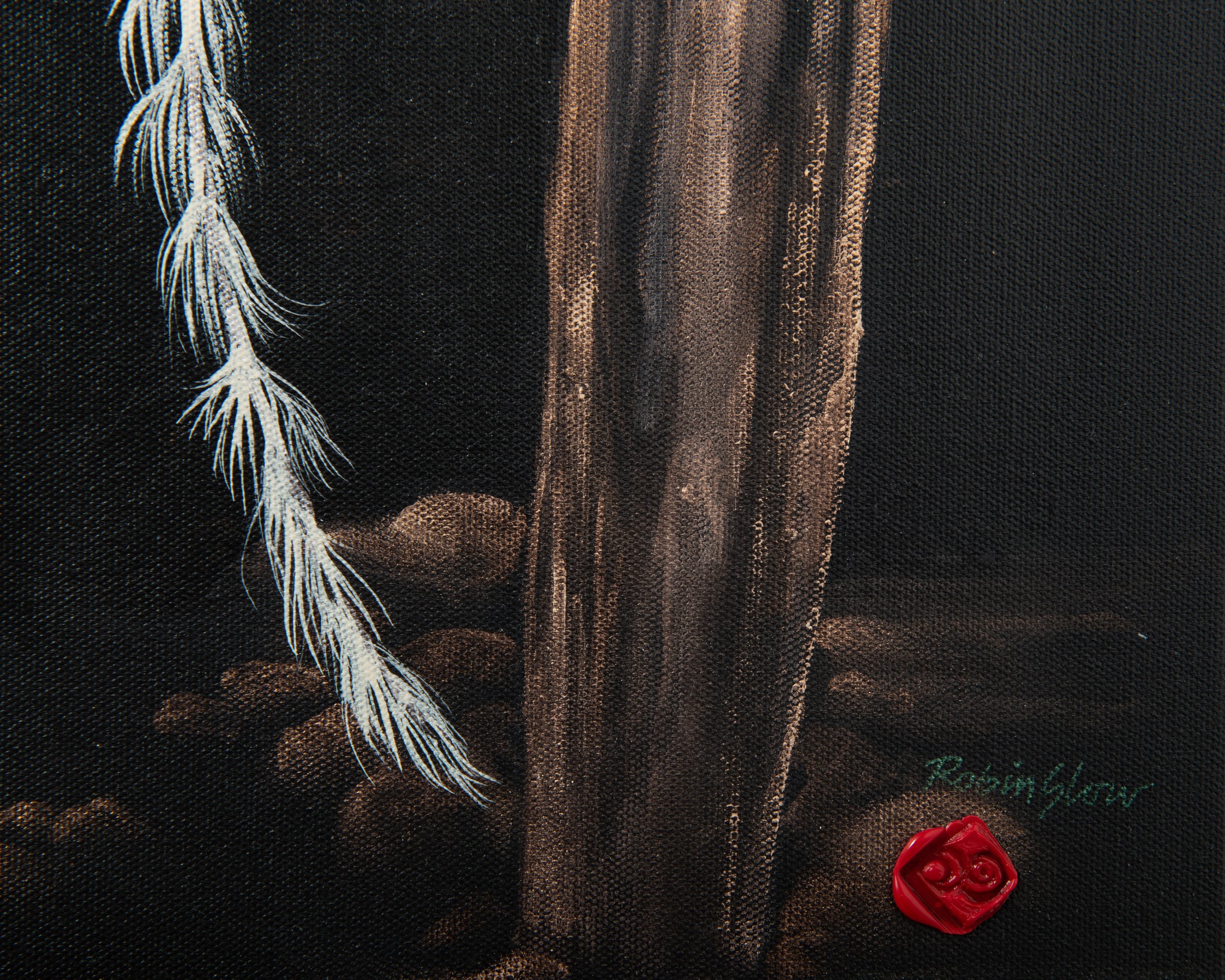IT WAS TE PŌ (OF DARKNESS), TE AO (OF LIGHT)
Kei a te Pō te tīmatatanga o te waiatatanga mai a te Atua. ko te Ao, ko te Ao marama, ko te Ao tūroa. It was the night the Atua sang the world into existence.
Acrylic & interference paint on canvas. Measures 145cm x 80cm.
SOLD
E KORE E NGARO TONA POUITANGA, TE MARAMA O TE TITIWAI
From the nothingness, hidden in the gloom comes the light of the titiwai (glow worm). The glowing lights falling from the ‘fishing threads’. They form the sides of the ara (pathways). Some say they lined the ara in the birthing of the children of Papatūānuku. They also formed the pathway for Maui in his journey to Hinenuitepo. Others give the name pūrātoke or bright spark! When we have all the titiwai coming together we have some light. The light of the bright sparks! Reference in this work has been given to Matariki and her children forming a pathway.
Acrylic interference paint & gold leaf on canvas. Measures 145cm x 80cm.
WAS $5,500 / NOW $4,125
HEI WAIATA
Kōkako (Story of Maui rewarding him for bringing water). Sounds of the forest (Wheke – daughter of Raukatauri) never seen.
Acrylic interference paint on canvas. Measures 145cm x 80cm.
SOLD
WHĀRIKI
Acrylic interference paint on canvas. Measures 73.5cm x 131.5cm.
SOLD
i hau pukeri
Acrylic, gold & copper foil on canvas. Measures 66.5cm x 144cm.
SOLD
PUATATANGI (dawn chorus)
Acrylic & gold foil on canvas. Measures 66cm x 144.5cm.
SOLD
ONEKAKA
Onekaka is the place in Mohua (Golden Bay, New Zealand) where transportation of kōkōwai (red ochre) took place. Today, only a small part of the wharf remains, but the kawau (Black Shags) still act as kaitiaki (guardians). The taurapa (stern-piece of a canoe) tells of the years of wake (canoes) landing there.
Acrylic, kōkōwai (red ochre) & gold leaf on canvas. Measures 80cm x 140cm.
SOLD
peita
The kōkōwai (red ochre) was gathered from Parapara (in Golden Bay) and used as a paint. It acted as a protector for many buildings.
Acrylic & kōkōwai (red ochre) on canvas. Measures 80cm x 140cm.
SOLD
Ātārangi
The pare represents the passing from one state to another. The manaia (guardian) figures on the end represent time with one foot up to the past and the other to the future. In the central figure of Tāne (God of the Forest) he separates his parents, Papatūānuku (Earth Mother) and Ranginui (Sky Father) and allows the light to enter the space. Below are the manu (birds) of Tāwhirimātea (God of the Winds). In the separation of the sky from the land, the blood from Ranginui fell on to Papatūānuku. This blood formed the kōkōwai. With the light also comes the shadows.
Acrylic, kōkōwai (red ochre) & gold leaf on canvas. Measures 80cm x 140cm.
SOLD
Te Kowhaiwhai Reo
The kōkōwai is the stone that created the ‘old’ paint. In this case it was sourced from Parapara Maunga (mountain). This was used in the creation of the kōwhaiwhai patterns providing the aspect of tapu. The story of the creation of kōkōwai comes from the separation of Ranginui (Sky) and Papatūānuku (Earth) where in the separation process Ranginui’s wrists were cut and the blood dripped down to Papatūānuku. The figures below are based on old figures where there was a space between one side of the figure and the other. We call this the ‘spirit’ line. To the side of these figures are the kaitiaki taniwha of the stone. Above is the manu Mohua, the old name of Golden Bay.
Acrylic, kōkōwai (red ochre) & gold leaf on canvas. Measures 80cm x 140cm.
SOLD
waka huruhuru
There is a very old story about the first people to Aotea. A group of people were being chased from their homeland from the North. They came to a new place where they saw the land meeting the sea for the first time. Looking out on to the horizon they wondered if they could move through where the sky meets the sea. To test it out they created a small waka from feathers and set it to sail on the waters. There was a giant storm and from this they surmised that the waka could not get through until a few days later the feather waka, worse for wear, appeared on the beach. The people set about building a waka based on the pattern created by the feathers. This became the Waka Huruhuru, said by some to have brought the patupaerehe, the maero and taniwha to this land.
The work is based on a large taniko pattern motif. The kowhaiwhai shows Nga Hau e Wha, the four winds from which we all have travelled from, the kokako greets with the kaikaranga. The tui brings the knowledge forward to Aotearoa – the land of the long white cloud.
Acrylic interference paint & gold leaf on canvas. Measures 1050mm x 1570mm
SOLD
manu mohua
The work references a number of aspects. The kowhaiwhai manu (bird) takes us back into time.
Relating to the earliest of marks made in Aotearoa. The central kowhaiwhai motif is the aroha form that surrounds the child (in an embryo). The wings of the parent push forward and upwards. Behind is the maunga that we relate to. Above is the manu, Mohua. Mohua is the old name of Golden Bay it also being the name of the threatened bird. The tui are the waiata experts, keepers of the knowledge and the kaitiaki.
Acrylic interference paint & gold leaf on canvas, 1570mm x 1050mm
SOLD
Parker Gallery - 90 Achilles Avenue, Nelson, New Zealand - 03 539 4280
















